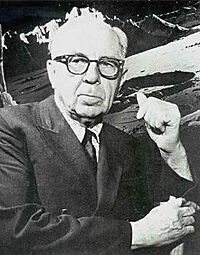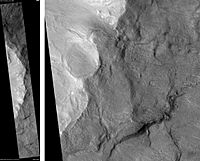Chesley Bonestell facts for kids
Quick facts for kids
Chesley Bonestell
|
|
|---|---|
 |
|
| Born | Chesley Knight Bonestell Jr. January 1, 1888 San Francisco, California, U.S. |
| Died | June 11, 1986 (aged 98) Carmel, California U.S. |
| Occupation | Artist |
| Period | 1944–1986 |
| Subject | Science, science fiction, space |
| Notable awards | Klumpke-Roberts Award (1976) |
| Spouse |
Mary Hilton
(m. 1911–1918)Ruby Helder
(m. 1920; died 1938)Mary Hilton
(m. 1940–1961)Hulda von Neumayer Ray
(m. 1962) |
| Children | Jane Bonestell (1912–1989) |
Chesley Knight Bonestell Jr. (born January 1, 1888 – died June 11, 1986) was an amazing American artist. He was a painter, designer, and illustrator. His incredible paintings helped inspire the American space program. They are still very important in science fiction art today. Bonestell is often called the "Father of Modern Space art" because he was one of the first to create detailed art about space.
Contents
Early Life and Learning
Chesley Bonestell was born in San Francisco, California. His birthday was January 1, 1888. As a young person, he went to several schools in San Francisco.
After finishing school in 1904, he worked for his grandfather's paper company. For the next three years, he also took evening art classes. He studied at the Hopkins Art Institute.
Becoming an Artist
Chesley Bonestell created his first space painting in 1905. He had just seen the planet Saturn through a large telescope. It was a 12-inch telescope at Lick Observatory in San Jose, California. He quickly went home to paint what he saw. Sadly, this painting was lost in the big San Francisco earthquake of 1906.
In 1907, Bonestell started studying architecture at Columbia University in New York City. He left in 1910 to work as a designer. He helped design parts of famous buildings.
In the 1920s, he moved to England for a while. He drew buildings for a newspaper there. When he returned to New York, he helped design the outside of the Chrysler Building. This building is famous for its unique art deco style. He also worked on the U.S. Supreme Court Building and other important structures.
Later, Bonestell moved to Hollywood. He became a special effects artist for movies. He created amazing background paintings for films like The Hunchback of Notre Dame (1939) and Citizen Kane (1941).
Space Art in Magazines

Bonestell then found a way to combine his movie skills with his love for astronomy. He started painting incredible scenes of space. In 1944, a series of his paintings appeared in Life magazine. These showed Saturn as seen from its different moons. People had never seen anything like them before. They looked so real, as if a photographer had actually been to space!
His painting "Saturn as Seen from Titan" is one of his most famous. Many people say it inspired thousands of careers in space science. He made these paintings look real by using clay models, photo tricks, and special painting methods.
After this success, Bonestell published more paintings in many magazines. These were later put into a popular book called The Conquest of Space (1949). He also worked on science fiction movies like Destination Moon and The War of the Worlds. He even painted over 60 covers for science fiction magazines.
His work was very important for the real space program. A scientist named Wernher von Braun asked Bonestell to draw his ideas for future space travel. Their work showed that spaceflight was possible very soon. It just needed money and determination. This helped kick-start America's space program in the 1950s.
Later Life and Legacy
Chesley Bonestell passed away on June 11, 1986, in Carmel, California. He was still working on a painting when he died.
Bonestell received many honors for his contributions to space exploration. He got a medal from the British Interplanetary Society. He was also placed in the International Space Hall of Fame. An asteroid and a crater on Mars are named after him. The crater is called Bonestell Crater. The asteroid is 3129 Bonestell.
His paintings are highly valued by collectors and museums. The National Air and Space Museum has many of his works. Wernher von Braun, the rocket scientist, once said that Bonestell was obsessed with making everything perfect.
Books with Bonestell's Art
Chesley Bonestell illustrated many books. Here are some of them:
- The Conquest of Space (1949) by Willy Ley
- Across the Space Frontier (1952)
- The End of the World (1953) by Kenneth Heuer
- The World We Live In (1955)
- The Exploration of Mars (1956)
- Man and the Moon (1961)
- Rocket to the Moon (1961)
- The Solar System (1961)
- Beyond the Solar System (1964)
- Mars (1964)
- Beyond Jupiter (1972)
- The Golden Era of the Missions (1974)
Movies with Bonestell's Art
Bonestell created special effects art for many films. Here is a short list:
- The Hunchback of Notre Dame (1939)
- Citizen Kane (1941)
- The Magnificent Ambersons (1942)
- Destination Moon (1950)
- War of the Worlds (1953)
- Conquest of Space (1955)
Documentaries About Bonestell
Chesley Bonestell appeared in a documentary called The Fantasy Film Worlds of George Pal (1985). A newer documentary about his life, Chesley Bonestell: A Brush with the Future, was made in 2018.
See Also
- Chesley Awards
- List of space artists


